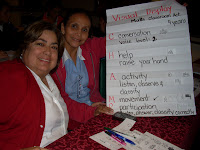 |
Front Door to the School
Parents are waiting to pick up their children at the end of the school day.
(You can click on any of the pictures to enlarge them.) |
Public School María Luisa Mariscal de Guevara is located in Guasmo Central, an impoverished area of Guayaquil on the Isla de Trinidad. As we were driving to the school, I was aware that the roads were getting narrower and narrower and both the roads and houses in poorer condition. For safety reasons, this is an area of the city Mike and I would never venture into by ourselves. I am thankful for the opportunity to visit the schools provided by the participants in my class who are administrators in the Ecuadoran Ministry of Education.
 |
| Preschool Children During Recess |
 |
| A Preschool Classroom |
The school has 116 children in the preschool, and 917 students in primary through the 10th grade. Ecuadoran law requires students to attend school through the 10th grade, although there are scant resources to find students who are truant or never enroll in the first place. This school doesn’t have 11th and 12th grade, but students can apply to attend another public school for the final two years.
 |
Snack Time in Preschool
Children bring their own snacks and lunch. |
Class sizes are similar to the other schools I have visited. A 1st basic class (5 year olds, equivalent to U.S. Kindergarten) has 27 students, 2nd basic (U.S. equivalent to first grade) has 40 students, and a 7th basic class has 41 students. There are about 54 students identified as having “learning problems,” although the school's administration didn’t have any documentation regarding type of disability, areas of need, or instructional programs the students were receiving. The teacher in charge of the students with learning problems has the title “maestro de aula de apoyo,” which translates to something like “support classroom teacher.” This teacher has a small office-sized classroom with a couple of short tables and some tiny little chairs.
 |
| Student Taking a Test in a Primary Classroom |
 |
Primary students are working on phonics skills with new materials purchased
through inclusive education funds from the government. |
Earlier this week I read in the newspaper that some pubic schools still had not been issued the government textbooks. The school year started in March. In this school I did see that students in some of the classes had one or two textbooks. Some of the books were photocopied.
 |
| A Typical Primay Classroom |
 |
| Some Upper Level Primary Students Share a Desk |
As with the previous school I visited, when I pulled out my camera during the recess period, I thought there was going to be a stampede. The students pushed at each other to get close, and I’m sure some would have gone down if I hadn’t put away my camera and some of the teachers come to help calm the crowd. I will be more careful at the next school! I am amazed at the way the children react to me. I don’t think I look all too different from them, but when I walk among them they all crowd around me, and as many as six or seven children will touch my arms as we’re walking. It makes me think that perhaps these children have never had the opportunity to see a “live” Caucasian person.
 |
A Primary Classroom
This photo shows about two-thirds of the students in the class. |
 |
| Children Pushing Forward to Get in the Picture |
 |
| Primary Students at Recess |
 |
| A Secondary Class |









































